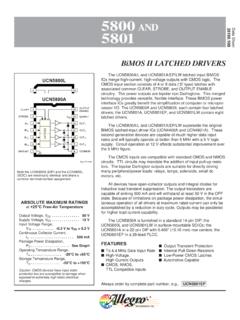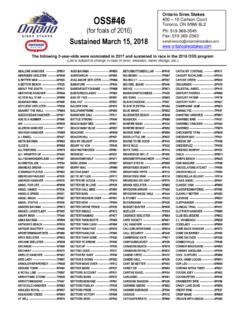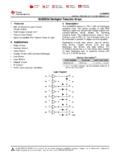Transcription of ZILOG Z80 PIO USER S MANUAL Page 1 of 22
1 ZILOGZ80 PIO user =S MANUALPage 1 of 22 TABLE OF CONTENTSC hapter 1. Introduction 3 Chapter 2.. 4 Chapter 3. Pin 6 Chapter 4. Programming the the interrupt an Operating the Interrupt Control 5. Mode (Mode 0).. Mode (Mode 1).. Bidirectional Mode (Mode 2).. Control Mode (Mode 3)..14 Chapter 6. Interrupt 7. the Interrupt Daisy Device 8. Programming Interrupt Interrupt PIO user =S MANUALPage 2 of 22 List of figures PageFigure 2 -1 PIO Block 5 Figure 2 -2 Port I/O Block 5 Figure 3 -1 PIO Pin 8 Figure 3 -2 PIO 44 - Pin PLCC Pin 8 Figure 5 -1 Mode 0 (Output) 5 -2 Mode 1 (Input) 5 -3 Port A, Mode 2 (Bidirectional) 5 -4 Control Mode (Mode 3) 6 -1 Interrupt Acknowledge 6 -2 Return From Interrupt 6 -3 Daisy Chain Interrupt 7 -1 Method of extending the InterruptPriority Daisy 7 -2 Example of I/O 7 -3 Control Mode 21 ZILOGZ80 PIO user =S MANUALPage 3 of 22 CHAPTER 1 Z8O Parallel I/O (PlO)
2 Circuit is a programmable, two port device which provides a TTLcompatible interface between peripheral devices and the Z80-GPU. The CPU can configurethe Z8O-PIO to interface with a wide range of peripheral devices with no other externallogic required, Typical peripheral devices that are fully compatible with the Z80-PIO includemost keyboards, paper tape readers and punches, printers, PROM programmers, etc. TheZ8O-PIO is packaged in a 40-pin DIP, or a 44-pin PLCC, or a 44-pin OFP. NMOS andCMOS versions are also available. Major features of the Z80-PlO of the unique features of the Z80-PlO that separates it from other interface controllersis that all data transfer between the peripheral device and the CPU is accomplished undertotal interrupt control.
3 The interrupt logic of the PIO permits full usage of the efficientinterrupt capabilities of the Z80-CPU during I/0 transfers. All logic necessary to implement afully nested interrupt structure is included in the PIO so that additional circuits are notrequired. Another unique feature of the PlO is that it can be programmed to interrupt theCPU on the occurrence of specified status conditions in the peripheral device. For example,the PlO can be programmed to interrupt if any specified peripheral alarm conditions shouldoccur. This interrupt capability reduces the amount of time that the processor must spend inpolling peripheral Two Independent 8-Bit Bidirectional Peripheral interface Ports with >Handshake=Data Transfer Control.
4 Interrupt Driven Handshake for Fast Response. Any One of Four Distinct Modes of Operation May be Selected for a Output-Byte Input-Byte Bidirectional Bus (Available on Port A Only)-Bit Control with Interrupt Controlled Handshake Daisy Chain Priority Interrupt Logic included to Provide for Automatic interruptVectoring Without External Logic. Eight Outputs are Capable of Driving Darlington Transistors All Inputs and Outputs Fully TTL Compatible Single 5V Supply and Single Phase Clock are PIO user =S MANUALPage 4 of 22 CHAPTER 2 PIO OVERVIEWA block diagram of the Z80-PIO is shown in Figure internal structure of the Z8O-PIO consists of a Z80-CPU bus interface, internal control logic, Port A I/O logic, Port B I/Ologic and interrupt control logic.
5 The CPU bus interface logic allows the PlO to interfacedirectly to the Z8O-CPU with no other external Logic. However, address decoders and/orline buffers may be required for large systems. The internal control logic synchronizes theCPU data bus to the peripheral device interfaces (Port A and Port B). The two I/O ports (Aand B) are virtually identical and are used to interface directly to peripheral Port I/O logic is composed of 6 registers with hand-shake control logic as shown inFigure 2-2. The registers include an 8-bit data input register, an 8-bit data output register, a2-bit mode control register, an 8-bit mask register an 8-bit input/output select register and a2-bit mask control 2-bit mode control register is loaded by the CPU to select the desired operatingmode(byte output, byte input, byte bidirectional bus, or bit control mode).
6 All data transferbetween the peripheral device and the CPU is achieved through the data input and dataoutput registers. Data may be written into the output register by the CPU or read back tothe CPU from the input register at any time. The handshake lines associated with each portare used to control the data transfer between the PIO and the peripheral 8-bit mask register and the 8-bit input/output select register are used only in the bitcontrol mode. In this mode, any of the eight peripheral data or control bus pins can beprogrammed to be an input or an output as specified by the select register. The maskregister is used in this mode in conjunction with a special interrupt feature.
7 This featureallows an interrupt to be generated when any or all of the unmasked pins reach a specifiedstate (either High or Low). The 2-bit mask control register specifies the active state desired(High or Low) and if the interrupt should be generated when all unmasked pins are active(AND condition) or when any unmasked pin is active (OR condition). This feature reducesthe requirement for CPU status checking of the peripheral by allowing an interrupt to beautomatically generated on specific peripheral status conditions. For example, in a systemwith three alarm conditions an interrupt may be generated if any one occurs or if all interrupt control logic section handles all CPU interrupt protocol for nested priorityinterrupt structures.
8 The priority of any device is determined by its physical location in adaisy chain configuration. Two lines are provided in each PlO to form this daisy chain. Thedevice closest to the CPU has the highest priority. Within a PlO port A interrupts havehigher priority then those of Port B. In the byte input, byte output or bidirectional modes, aninterrupt can be generated whenever a new byte transfer is requested by the peripheral. Inthe bit Control mode an interrupt can be generated when the peripheral status matches aprogrammed value. The PIO provides for complete control of nested interrupts. That is,lower priority devices may not interrupt higher priority devices that have not had theirinterrupt service routine completed by the CPU.
9 Higher priority devices may interrupt theservicing of lower priority an interrupt is accepted by the CPU in Mode 2, the interrupting device must providean 8-bit interrupt vector for the CPU. This vector is used to form a pointer to a location inthe computer memory where the address of the interrupt service routine is located. The 8-bit vector from the interrupting device forms the least significant eight bits of the indirectZILOGZ80 PIO user =S MANUALPage 5 of 22pointer while the I Register in the CPU provides the most significant eight bits of thepointer. Each port (A and B) has an independent interrupt vector.
10 The least significant bit ofthe vector is automatically set to a 0 within the PlO since the pointer must point to twoadjacent memory Isolations for a complete 16-bit PlO decodes the RETI (Return from interrupt) instruction directly from the CPU databus so that each PlO in the system knows at all times whether it is being serviced by theCPU interrupt service routine without any other communication with the (2 Bits)MaskReg(8 Bits)DataOutputReg(8 Bits)DataInput(8 Bits)Input DataInternal BusModeControlReg(2 Bits)Output EnableInput/OutputSelect Reg(8 Bits)8 BitPeripheralData OrControl BusFigure 2-2. Port I/O Block DiagramHandshakeLinesZILOGZ80 PIO user =S MANUALPage 6 of 22 CHAPTER 3 PIN PIN DESCRIPTIONA diagram of the Z8O-PIO pin configuration is shown in Figure 3-1.





